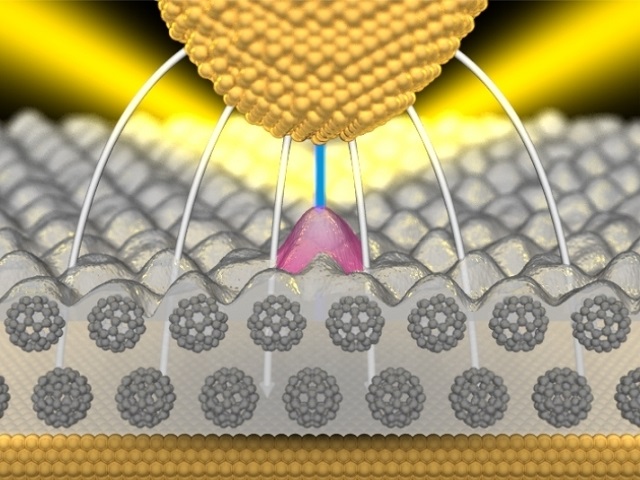 Researchers at the Max Planck Institute for Solid State Research apply a voltage between a gold surface coated with a layer of spherical carbon molecules and the tip of a scanning tunneling microscope. The resulting electric field (indicated by the grey arrows in the diagram) can be regulated by the level of the voltage and the distance between the tip and the metal surface. With a particular field strength, the single molecule (in magenta) becomes electrically charged, which immediately leads to electrical energy being converted to light (the yellow wave). © MPI for Solid State Research
Researchers at the Max Planck Institute for Solid State Research apply a voltage between a gold surface coated with a layer of spherical carbon molecules and the tip of a scanning tunneling microscope. The resulting electric field (indicated by the grey arrows in the diagram) can be regulated by the level of the voltage and the distance between the tip and the metal surface. With a particular field strength, the single molecule (in magenta) becomes electrically charged, which immediately leads to electrical energy being converted to light (the yellow wave). © MPI for Solid State Research
A team of researchers from the Max Planck Institute for Solid State Research, the Karlsruhe Institute of Technology, and the Max Planck EPFL Center have collaborated to develop a nanolamp with integrated transistor control. The nanolamp is a light source that uses a single molecule to convert an electrical voltage pulse into a pulse of light.
The single molecule works like a transistor-controlled light switch, which can also regulate light intensity. The extremely rapid light switching ability of the molecule could be used in nano-components that are used for converting electrical signals into optical signals in the GHz frequency range.
When light shines on organic dyes they provide colour. In electric light sources such as organic light-emitting diodes, they shine by themselves. However, the brightness is controlled by transistors. These two functions have been combined in a single molecule in this nanolamp.
The researchers placed a dye molecule over a layer of Buckminsterfullerenes. This layer coats a gold metal carrier which functions as an electrode. A scanning tunneling microscope (STM) was used and its tip was used as the other electrode. The surface was scanned with the tip and the light that was emitted was measured. The distance between electrical contacts and the electrical voltage between the STM tip and the gold carrier was used to regulate the electric field on the molecule. The lamp switched on when it exceeded 2.5V/nm and worked in the same way as a light-emitting transistor. The electrical energy got converted into light energy through plasmons.
At the molecule's location, change in electric field decides the production of light. Digital information can be transferred with light, and "light off" status can be considered to be zero and "light on" status as one data bit. A bit stream is produced when modulation takes place. This is emitted as light which transfers data. Tiny voltage changes above the threshold value switches the light on at a rapid rate within a billionth of a second. The speed of the light switch is controlled by how the molecule controls the light intensity.
Mechanical light switches use levers that cause unavoidable capacitances without production of light. More energy and time is needed for charging these parasitic capacitors when larger switches are used. In this new process the single molecule has a size of a size of a millionth of a millimetre and requires few mV of energy, which enables rapid switching. This molecular light source holds promise for efficient information transmission.
References